Humans see, humans do: After the first horse drawn on the first cave and the first pot incised with a decorative line, everything became imitation. You don’t need a weatherman to know which way that wind blows, or that in the contemporary period, it blows harder.
In selecting the 12 artists featured in Image Transfer: Pictures in a Remix Culture, associate Henry curator Sara Krajewski looked for those whose engagements with image recycling make them visual mix masters of note, those who aren’t just riding the currents but helping to steer them.
On the whole, she succeeded. Image Transfer is exactly the kind of exhibit the Henry should be doing. It has wit, depth and subtlety with an undertow of numbed tragedy. Image Transfer describes a trash world that constricts rather than enlarges upon the idea of possibility, as if we all live in a snow globe filled with images raining down on our indifferent heads, except that we too contribute to the glut.
What does the glut bring? Just as God told Moses not to look directly at the Burning Bush, Jordan Kantor suggests we refrain from direct engagement with the image world, for the same reason. Circuits will be blown, eyes burned.
Jordan Kantor Eclipse, 2009 screenprint on clear polycarbonate and silver myler sheet, and Eclipse (color inversion) oil on canvas 2009
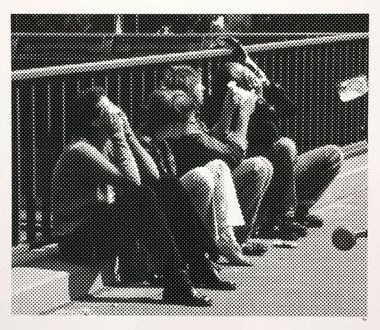
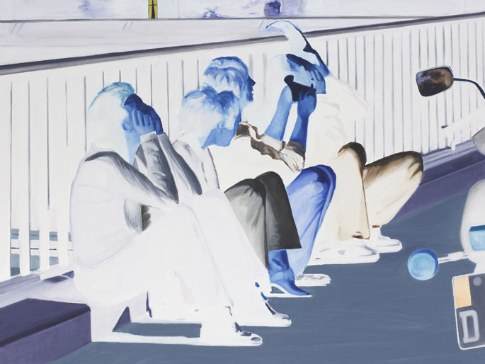 Using flash cards, Matt Keegan‘s mother teaches brain-damaged children non-English speakers how to pick the right word for the right emotion. In a video that’s part of his installation titled Images are Words (2010), she looks at situations featured in photos and decodes their central meaning with a single word. Because there rarely is such a thing as one meaning, her answers diverge from the life’s experience of any given viewer. The rest of the gallery is filled with heaps of laminated images hand assembled by her, a deluge. The distance between the simplicity of her goal and the complexity of the result endlessly multiplies. Like her slowest students, we do not understand.
Using flash cards, Matt Keegan‘s mother teaches brain-damaged children non-English speakers how to pick the right word for the right emotion. In a video that’s part of his installation titled Images are Words (2010), she looks at situations featured in photos and decodes their central meaning with a single word. Because there rarely is such a thing as one meaning, her answers diverge from the life’s experience of any given viewer. The rest of the gallery is filled with heaps of laminated images hand assembled by her, a deluge. The distance between the simplicity of her goal and the complexity of the result endlessly multiplies. Like her slowest students, we do not understand.
Pried from their original context, glamorous prints of dead stars move freely from screen to screen, both present and elusive, even with a rock on their heads.
Marlo Pascual Untitled, 2009, Digital print and rock
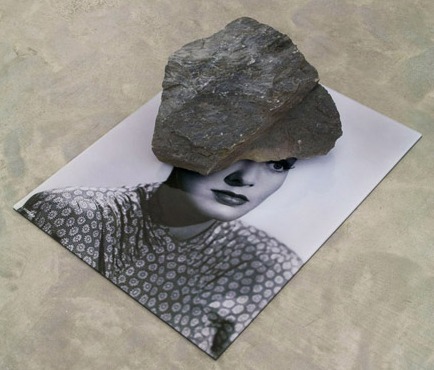 Siebren Versteeg‘s color-coded flags imprinted with viral pictures celebrate the dominance of unstable sign over solid sense. Karl Haendel draws a dead flow, a condensed, cluttered verison of James Rosenquist without the color or early David Salle without the S&M overtones. Sean Dack works with processing mistakes, allowing his figures to hover on the point of disintegration. (Seattle’s Norie Sato did something similar in the 1970s, with paintings and videos inspired by electronic snow.) Carter Mull blurs his consumables and taints them with electronic rot.
Siebren Versteeg‘s color-coded flags imprinted with viral pictures celebrate the dominance of unstable sign over solid sense. Karl Haendel draws a dead flow, a condensed, cluttered verison of James Rosenquist without the color or early David Salle without the S&M overtones. Sean Dack works with processing mistakes, allowing his figures to hover on the point of disintegration. (Seattle’s Norie Sato did something similar in the 1970s, with paintings and videos inspired by electronic snow.) Carter Mull blurs his consumables and taints them with electronic rot.
Lisa Oppenheimer drives a stake through the timid heart of exhausted metaphor.
The Sun is Always Setting Somewhere Else (detail) 2006 Slide projection
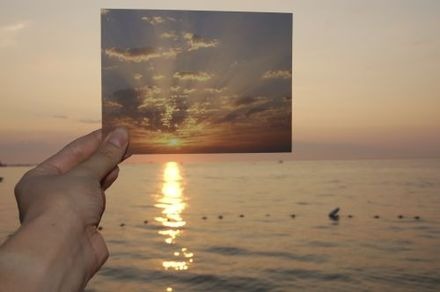 Her critique of the banal is itself in danger of banality, as others have done similar. I like Letah Wilson‘s version better, not in the show:
Her critique of the banal is itself in danger of banality, as others have done similar. I like Letah Wilson‘s version better, not in the show:
Wilson Right Back at You
Digital C-print, flashlight, rocks, 42 x 30 x 46 inches, 2009
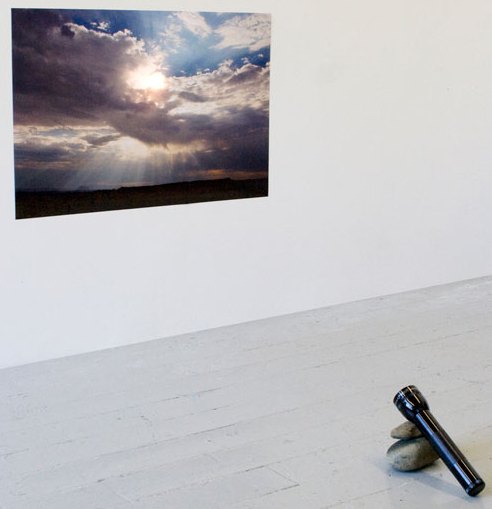 Once the image stream becomes art, there is hierarchy.
Once the image stream becomes art, there is hierarchy.
In her excellent catalog essay, Krajewski enlarges upon Oppenheim’s enterprise, saying she “seeks out representations of significant historical moments” but views them from the edges of their meaning. Tom Stoppard’s version of this theme – Rosencrantz and Guildenstern are Dead from 1966, has nothing to fear from Oppenheim. He still owns it, across all art disciplines. On the other hand, Image Transfer might not be doing Oppenheim justice, judging from other work available online.
This show carries itself without a lot of wall text, but I think a brief note explaining that Amanda Ross-Ho‘s Camera 1, Camera 2 derives from a magazine reproduction of Jeff Koons’ stainless steel Rabbit from 1986. is in order. Ross-Ho shot into the shiny belly of Koons’ sleek beast and played with its reflections. If you don’t know that and there’s no reason to suspect anyone would, the piece is a mystery.
Camera 2, digital Chromgenic print. 2007
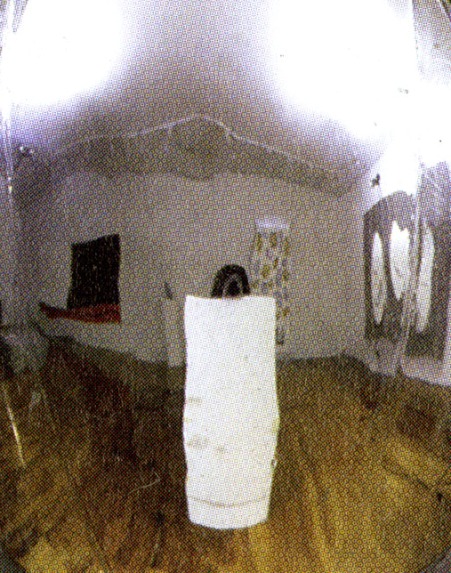 Through repetitions, Sara VanDerBeek creates photos that aspire to be sculptures. Erika Vogt doubles herself doing different things, becoming
Through repetitions, Sara VanDerBeek creates photos that aspire to be sculptures. Erika Vogt doubles herself doing different things, becoming
the detective of her own crime scene, both corpse and cop. Finally, there’s Kelley Walker, who heats the cool of old advertisements.
I admire how each of these artists echo and expand on each other’s work, which makes the exhibit more than the sum of its parts. Many hours can be spent mulling through it. Because it is co-organized by the Henry and Independent Curators International, it is likely to travel. As such, it is an opportunity missed for the Northwest artists who could have shined in this context.
As usual, the Henry is in violation of the bloom-where-you’re-planted rule. Nobody’s asking for a mercy hook up, but there are at least half-a-dozen artists who could have added significantly to this show’s consequence, such as Margot Quan Knight, Mike Simi, Sol Hashemi, Claude Zervas, Vanessa Renwick and Jason Hirata. It is crucial for NW artists to be seen in a larger context. By excluding them from a perfect opportunity, the Henry is missing a chance to mean more. I know that the Henry would hesitate to mount an exhibit of 12 male-only artists, even less male-only white artists. Race and sex are factors. Recognizing the artists who live here needs to be one too.



I wish there was a link to it on his site, but have you seen Thom Heileson’s “101 Sunsets/101 Love Songs”? It fits right in with this group – it’s 101 photographs of sunsets, taken from the internet – I think he even lined the sun up in all of them – coupled with 101 love songs, played all at once. It’s pretty amazing.
Hi Jenny. Yes I have and you’re right. Thom Heileson’s sunsets fit well into the theme, as well as being straight-up amazing.
i am very happy that you did mention the fact of the missing seattle artists in this show – a fact that one could observe not for the first time. this is also one of the significant differences that would have to be named as another reason for the so very different recognition of vancouver and seattle artists outside of the region, vancouver’s institutions stay in for their artists and probably this is the case in most other places of the world – to recognize, value and to place in a broader context and perspective what is happening locally is a job that belongs to an institution. no-one else will do this if this is not happening in the place itself.
Hi Regina,
I’d like to clarify how Matt Keegan’s mother used the flashcard images – she was an ESL instructor and the images were used in teaching Spanish speakers vocabulary. That’s just the starting point for this work about shifting meaning and context, stock photography and language.
Sara
Thanks for this! After reading other accounts, I’d decided to give this show a miss, but you make it sound fun. A show that takes the pulse of the present moment doesn’t have to be shallow. I usually associate you with old painters. Thanks for surprising me.
I have to be anonymous because I’m an artist and I know the curator and want to continue to know the curator. Hell yes, this is a missed opportunity! Curators at the major museums in Seattle act as if they’re missionaries, bringing art to the ignorant. Shouldn’t it be more about integration than exclusion? The Henry has no idea how much damage it does to the NW community by leaving us out of something at least one of us or even two could have been included in. Come on! Is the Henry saying nobody in the region deserves to be in this show? Wow. Then it wants us to support it! There are teeny marginal opportunities the Henry makes a big fuss about on Hank Blog! Put us in the ring, coach, or play for another team. Judging from this show, I think Sara wants to live in LA. Go to LA, alright already. Can’t the Henry find one curator with global awareness and regional depth? We. Want. To. Be. In. This. Kind. Of. Important. Show. Stop throwing scraps and serve dinner.